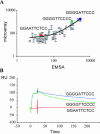Quantitative high-throughput analysis of transcription factor binding specificities
- PMID: 14990752
- PMCID: PMC390317
- DOI: 10.1093/nar/gnh042
Quantitative high-throughput analysis of transcription factor binding specificities
Abstract
We present a general high-throughput approach to accurately quantify DNA-protein interactions, which can facilitate the identification of functional genetic polymorphisms. The method tested here on two structurally distinct transcription factors (TFs), NF-kappaB and OCT-1, comprises three steps: (i) optimized selection of DNA variants to be tested experimentally, which we show is superior to selecting variants at random; (ii) a quantitative protein-DNA binding assay using microarray and surface plasmon resonance technologies; (iii) prediction of binding affinity for all DNA variants in the consensus space using a statistical model based on principal coordinates analysis. For the protein-DNA binding assay, we identified a polyacrylamide/ester glass activation chemistry which formed exclusive covalent bonds with 5'-amino-modified DNA duplexes and hindered non-specific electrostatic attachment of DNA. Full accessibility of the DNA duplexes attached to polyacrylamide-modified slides was confirmed by the high degree of data correlation with the electromobility shift assay (correlation coefficient 93%). This approach offers the potential for high-throughput determination of TF binding profiles and predicting the effects of single nucleotide polymorphisms on TF binding affinity. New DNA binding data for OCT-1 are presented.
Figures


Similar articles
-
Optimal Oct-2 affinity for an extended DNA site and the effect of GST fusion on site preference.Arch Biochem Biophys. 2001 Jan 15;385(2):397-405. doi: 10.1006/abbi.2000.2181. Arch Biochem Biophys. 2001. PMID: 11368023
-
A consensus DNA recognition motif for two KDWK transcription factors identifies flexible-length, CpG-methylation sensitive cognate binding sites in the majority of human promoters.J Mol Biol. 2001 Dec 14;314(5):1029-39. doi: 10.1006/jmbi.2000.5198. J Mol Biol. 2001. PMID: 11743720
-
Involvement of an octamer-like sequence within a crucial region of the androgen-dependent Slp enhancer.DNA Cell Biol. 1997 Jan;16(1):45-57. doi: 10.1089/dna.1997.16.45. DNA Cell Biol. 1997. PMID: 9022044
-
[Double-stranded DNA microarray: principal, techniques and applications].Yi Chuan. 2013 Mar;35(3):287-306. doi: 10.3724/sp.j.1005.2013.00287. Yi Chuan. 2013. PMID: 23575535 Review. Chinese.
-
The virtuoso of versatility: POU proteins that flex to fit.J Mol Biol. 2000 Oct 6;302(5):1023-39. doi: 10.1006/jmbi.2000.4107. J Mol Biol. 2000. PMID: 11183772 Review.
Cited by
-
Integrated approach for the identification of human hepatocyte nuclear factor 4alpha target genes using protein binding microarrays.Hepatology. 2010 Feb;51(2):642-53. doi: 10.1002/hep.23357. Hepatology. 2010. PMID: 20054869 Free PMC article.
-
Inferring binding energies from selected binding sites.PLoS Comput Biol. 2009 Dec;5(12):e1000590. doi: 10.1371/journal.pcbi.1000590. Epub 2009 Dec 4. PLoS Comput Biol. 2009. PMID: 19997485 Free PMC article.
-
Acyl chloride-modified amorphous carbon substrates for the attachment of alcohol-, thiol-, and amine-containing molecules.Langmuir. 2009 May 5;25(9):5120-6. doi: 10.1021/la804140r. Langmuir. 2009. PMID: 19317418 Free PMC article.
-
Tracking transcription factor complexes on DNA using total internal reflectance fluorescence protein binding microarrays.Nucleic Acids Res. 2009 Jul;37(13):e94. doi: 10.1093/nar/gkp424. Epub 2009 May 31. Nucleic Acids Res. 2009. PMID: 19487241 Free PMC article.
-
Interactions between Ibrutinib and Anti-CD20 Antibodies: Competing Effects on the Outcome of Combination Therapy.Clin Cancer Res. 2016 Jan 1;22(1):86-95. doi: 10.1158/1078-0432.CCR-15-1304. Epub 2015 Aug 17. Clin Cancer Res. 2016. PMID: 26283682 Free PMC article.
References
-
- Benos P.V., Lapedes,A.S. and Stormo,G.D. (2002) Is there a code for protein-DNA recognition? Probab(ilistical)ly. Bioessays, 24, 466–475. - PubMed
-
- Bulyk M.L., Gentalen,E., Lockhart,D.J. and Church,G.M. (1999) Quantifying DNA-protein interactions by double-stranded DNA arrays, Nat. Biotechnol., 17, 573–577. - PubMed
Publication types
MeSH terms
Substances
LinkOut - more resources
Full Text Sources
Miscellaneous

